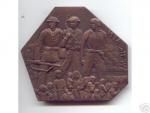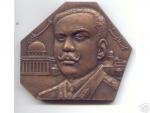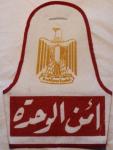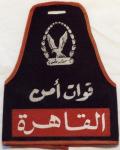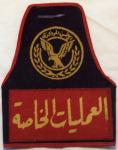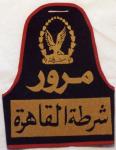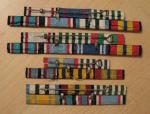
ChrisW
Patron-
Posts
310 -
Joined
-
Last visited
Content Type
Profiles
Forums
Blogs
Gallery
Events
Store
Everything posted by ChrisW
-
Here's the reverse of the trial design, which was unchanged for the final design. It depicts threeEgyptian soldiers marching towards the right, with their heads turned to theleft. From left to right, they area Navy sailor wearing a helmet and carrying a Lee Enfield Mk III rifle, an Armysoldier wearing battledress and helmet with a slung rifle, and an Air Forcepilot wearing a flight suit and flying helmet, with holstered pistol on hiship. Underneath them are variousPalestinian refugees fleeing burning and destroyed buildings in thebackground. On the right edge ofthe medal is the Islamic date 1367, and the corresponding Christian date 1948,both in Arabic.
-
Going through my collection and files the other day, I realized I had quite a bit of material on Egypt's Palestine War campaign medal, so thought I might try to put it all together here. Hope it's of some interest. The Palestine Medal was the first modern Egyptiancampaign medal, for service in the 1948-1949 Arab-Israeli war (aka Palestine War, War of Israeli Independence). For collectors this medal is one of the most commonly-seen andwidely-available modern Egyptian medals. (Also, interestingly, it is usually found with the ribbon intact, unlikemany other modern Egyptian medals.) This availability leads me to conclude that it was widely issued toEgyptian military personnel (again, unlike most other modern Egyptian service medals, which seem to mostly exist in ribbon form.) The exact criteria are unknown – for example, whatperiod of time and geographic area qualified, or whether Egyptian civilianssuch as the Muslim Brotherhood volunteers were eligible. The meaning of the distinctive shape of the medalis unknown. It is an irregularseven-sided shape, which may represent a stylized outline of the Old City ofJerusalem. Dimensions are 45mm at the widest point, and 36mmat the tallest (not counting the suspension.) The ribbon is 37mm wide, with equal stripes ofgreen, red, yellow, red, and green. The meaning of the ribbon colors are also unknown. The colors of the Egyptian flag at thetime was green and white. ThePalestinian national flag is red, white, black, and green. The first group of images here are from what looks like a trial design for the medal, by the designer Tawfiq Bichay. These images are taken from an internet auctionwebsite, back in 2004. If I recall, this piece wasconsiderably larger than the actual medal, more like a clay or bronze model rather than the actual medal itself. The obverse features an obliqueview of King Farouq, though a rather unflattering one, with heavily-lidded eyesand rather comical mustache. (Ican see why King Farouq may have asked the designer to go back to the drawingboard.) Otherwise it's identical to the design used on the actual medal itself.
-
Doc, Can't help with the medal itself, but a more likely translation of taqdir is "appreciation." Cheers, Chris
-
Queen introduces new military medal
ChrisW replied to Bob's topic in Great Britain: Orders, Gallantry, Campaign Medals
The most detailed article I've seen is on the MOD website: http://www.mod.uk/DefenceInternet/DefenceN...allenTroops.htm -
Well, Germany did have some advisors/pilots in Iraq in 1941-42 (I think), but this seems like it's more likely a modern-day imitation of the cuff titles intended as souvenirs for international troops serving in Iraq right now. During Operation Desert Shield/Desert Storm, the US Marine Corps locally used a globe-and-anchor on palm tree insignia that was reminiscent of the Afrika Korps insignia. This may be a similar influence from the Wehrmacht.
-
A book on Egyptian civil court uniforms??? I would be extremely interested in any further details, if available. There are a few Egyptian-published books (many in English) that feature photos of uniforms of royalty and civil servants, but as far as I know none specifically on the uniforms themselves. I've spent quite a lot of time traveling in Egypt and rooting around in bookstores, with limited success. There are of course a number of good bookstores and publishers in Cairo, where you can occasionally find surprises. The American University in Cairo Press publishes a number of illustrated books on 19th and early 20th century Egypt (with some incidental photos of uniforms in them), they're one of the few Egyptian bookstores/publishers with a web presence http://www.aucpress.com/t-aucbookstores.aspx though their website is often extremely shaky, and I'd be reluctant to order anything directly from them -- most of their books are available on Amazon and elsewhere. Chris
-
It's not every day you read about Iraqi military insignia on the front page of the Washington Post.... http://www.washingtonpost.com/wp-dyn/conte...ml?hpid=topnews A Military Lexicon The military aesthetic may prove to be this occupation's most lasting cultural artifact. If the British can claim credit for an array of industrial words used by Iraqis, including "radiator" and "machine," the Americans are responsible for a military lexicon that is still evolving. "Hummer" has entered Iraqi dialect as the word for the armored jeeps known as Humvees, as has the Arabic-inflected plural, Hummer-at. "Buffalo" is the word for MRAPs, the hulking Mine Resistant Ambush Protected vehicles. "Chocolate, mister!" or "Soccer ball, mister, soccer ball!" children shout to troops in Sadr City, a Baghdad slum of soggy trash and stagnant pools of sewage. Badg-at has become Iraqi Arabic for identity cards. Other words and phrases have been picked up from soldiers at checkpoints or conducting house raids or foot patrols: "Relax," "Please," "Sorry," "No problem," "Oh, my God," "Give me five." Almost any youth can hurl a string of American expletives whose Arabic equivalent would earn them a slap across the face. The war has inspired new Arabic words, as well. Hawasim, the name Hussein bestowed on his last battle in 2003, has come to mean booty looted in its aftermath. Arabic rendered literally from English at checkpoints -- "Prepared to capture criminals" or "Prepared to help" -- reads like the Arabic subtitles of an American movie. As in the Palestinian territories, where security forces sometimes copy the style of their Israeli occupiers, Iraqi soldiers are now sometimes indistinguishable from their American counterparts, resembling a scaled-down version of a football player. There is the desert camouflage, along with sunglasses and, occasionally, gloves. The black leather boots of the Hussein era have given way to a khaki suede variety. Holsters have gone from the hip to the thigh. The soldiers are equipped with kneepads, though they usually droop down to their ankles. No one was seen with a flak jacket before the invasion. Nor did anyone roll up their sleeves or tuck their pants into their boots. Even the posture is American: rifle carried high, finger on the trigger. And a fist thrust forth has come to mean stop. "They look like peacocks," declared Abu Ali Rubai, a 60-year-old uniform vendor. "They wear this and that," he said, pointing at a holster nicknamed Rambo, combat boots called Swat, and plastic handcuffs. "They're like a child playing with toys." He ruffled through bags filled with the gold-colored insignia of the old army's medical corps, tanks, special forces and artillery. He pointed out the colors of the berets that no one buys anymore -- blue for air force, beige for infantry and red for military police. Then he grabbed fistfuls of new badges, most of them in English and Arabic. There was Special Forces, with its skull and crossed arrows (sometimes written as Special Farces). "Iraq Army" was printed in English. So was SWAT. One badge read, "Ministry of Interiors." Rubai cast a longing eye at his favorite uniform, worn by Abdel-Karim Qassem, the officer who overthrew the monarchy in 1958, in a portrait that hangs behind his desk. It was a woolen, British-style uniform with a hat known as the sidara, or faisaliyya. Four blue versions of the hat still hung from nails in the wall, gathering dust. "The old ones were more distinguished," Rubai said. ? 2009 The Washington Post Company
-
Interesting that it has both the Iraqi and Palestinian flags, and a map of the whole Arab world. Possibly a propaganda effort to create an illusion of solidarity against Iran?
-
This one is a bit of a mystery. It doesn't look like any other Egyptian Police brassard -- the white color, the Republican eagle -- but I did catch a glimpse of it being worn in 1994, by what might have been cadets of the Police Academy or one of the adjutant's schools. And I did buy it in a Police supply shop. The Arabic reads "amn al-wahda" which might be "unit security," whatever that means.
-
-
-
Now the Central Security Forces. This is the basic CSF brassard, with the round CSF logo rather than the Police one. The Arabic reads "al-Amn al-Markazi."
-
-
Since the early 1980s, brassards are worn on the left sleeve by many conscripts (and some warrant officers and adjutants) of the Egyptian Interior Ministry. Most of the major departments/directorates of the Police and the Central Security Forces have their own distinctive brassard, often in several styles, and they are the most distinctive item of Police insignia. Most brassards incorporate a crude reflective quality for night visibility -- colored ground glass, glued on. The first one here is from the Port Police (formally the General Directorate of Port Security, in the Public Security Sector). The eagle in the wreath is the standard Police logo. The Arabic reads "Amn al-Mu'any", literally Port Security.
-
Just as an aside, some Egyptian ribbon bars from the 1970s-1990s used a similar method of construction -- thick colored thread or yarn glued onto metal bars. See the Egyptian ribbon bars postings on the Middle East forum. The Egyptian ones, however, mostly look TERRIBLE -- this one is beautiful by comparison!
-
Help confirm ID of a German Panzer
ChrisW replied to fackerman64's topic in Armour, Vehicles, Ships & Aircraft
Frank, I'm no expert on German armor, so I won't hazard a guess. But I would suggest that, if you haven't already tried it, to post these photos on www.missing-lynx.com, a dedicated armor modeling forum. There are LOTS of folks there who would find these photos of great interest, and probably have all sorts of information for you. Don't get me wrong, I thoroughly love GMIC for all subjects medal/uniform/insignia-related, but sometimes the forums on military hardware seem a little quiet.... Hope this is of some help! Cheers, Chris -
Very nice, Chris! I'm just looking at a thread on militaryphotos.net, which identifies these as being worn from June 1963-1968. http://www.militaryphotos.net/forums/showt...7395&page=3 Interesting mounting on these. Cheers, Chris
-
As you say, Ed, it's difficult to disentangle the Egyptian and Syrian ribbons during the UAR period. It's interesting to see that some of the ribbons on this Syrian ribbon bar are identical to Egyptian ones -- Army and Air Force commemorative medals, Victory, etc. I always thought these were purely Egyptian awards; they certainly continued to exist in Egypt after the UAR period.
-
Paul, Just came across your question, and I offer a very belated and only speculative/partial explanation. I suspect that Sudan, as well as Egypt and probably other countries, realized that producing and issuing both full-sized medals and ribbons was prohibitively expensive. Sudan probably doesn't have a domestic manufacturer of full-sized medals, and would have to order them from abroad. The Sudanese government could charge for the medals, which would make them only available to wealthier officers. And there would only be limited opportunities to wear the full-sized medals.
-
arabic badge - please help to identify
ChrisW replied to vorbeste's topic in Middle East & Arab States
By the standards of Egyptian insignia, they're not very rare. On Ebay, for example, Commando and Paratroop insignia and jump wings are probably the most common Egyptian insignia -- one set usually shows up for auction every few months. But they usually seem to sell, so there would seem to be a bit of a market for them. Like I said, there are numerous minor variations which might make them more interesting. Shameless self-promotion: I published a short article on Egyptian commando and paratroop insignia in the October 2008 issue of Military Trader. Hope this helps, Chris -
arabic badge - please help to identify
ChrisW replied to vorbeste's topic in Middle East & Arab States
Laszlo, This is the insignia of the Egyptian Commandos, worn on the sleeve. The arc says "Al Saiqa," (literally "thunderbolt"), the standard Arabic term for commandos. Most of these are made at Maison Tawfiq Bichay, and are marked on the back. There are numerous minor variations in the design. Regards, Chris -
Very nice finds! You must have spent several hours in the Khan Khalili to come up with these. It's frustrating that so many medals available there lack ribbons, and often the suspensions. The 25th Anniversary of Sinai Liberation medal is especially nice -- this is a new one to me. (Sinai Liberation Day is April 25, 1982, so this medal would presumably have first been issued in 2007.) Did you find this one at Bichay? Thanks for posting these! Chris
-
Thanks for posting these! It's always nice to know there's a real person behind the medals we study. Here's how I read the larger ribbon bar: Row one: Liberation Order with Palm; ??? (possibly Military Medal of Republic?); Evacuation Row two: Independence; Victory; Long Service & Good Example? Row three: ??? (possibly Palestine War?); ??? (possibly Mohammed Ali?); Army Day; ??? (possibly Order of Merit???) Seems to be a fairly typical set of awards for a career officer from the 1940s-1970s. Because I don't see a October 1973 War medal, I assume the photo was taken before that war?
-
And here are the other four. The top one is a rare clutch-back example, made by Bichay. I removed one of the backs to more clearly show the fitting. The bottom three are colored thread styles. Most of the colored thread styles seem to have paper backing, probably to protect loose threads. Again, in all cases the cloth is glued to the metal bars. This is probably one reason why ribbons are not necessarily worn in order of precedence. If an officer earns a new medal, he will have to have a whole new ribbon bar made. He would probably also wait until he gets 2-4 new ribbons (i.e., a new row) and just add the new row to an existing row.
-
The backsides of my ribbon bars. These four are typical Bichay manufacture, with pin backs. Cloth ribbons glued to metal bars, each metal bar fastened to each other with two hook-like devices.

